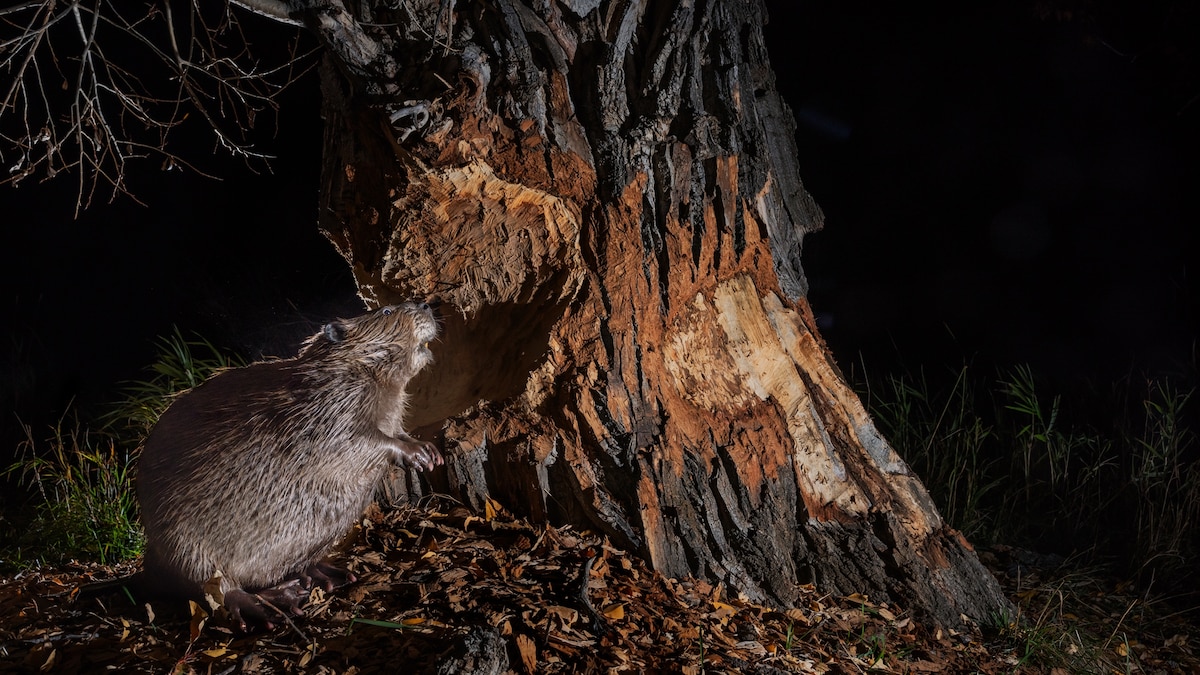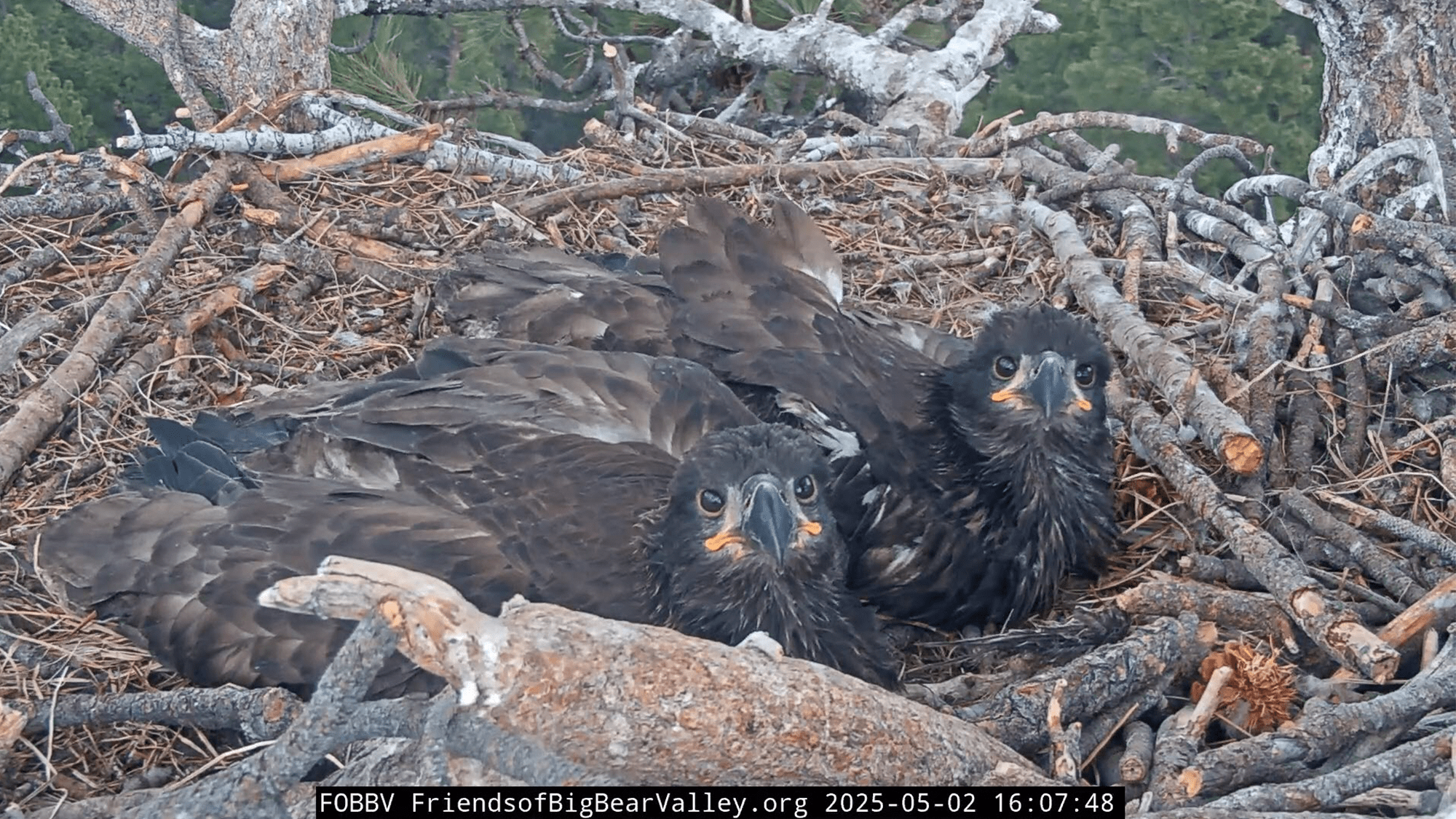Now Reading: Could beavers be the secret to winning the fight against wildfires?
-
01
Could beavers be the secret to winning the fight against wildfires?
Could beavers be the secret to winning the fight against wildfires?

The East Troublesome fire erupted on October 21, 2020, whipped by strong winds and fueled by drought-parched forests. The fire roared through northern Colorado’s spruce and fir woods; it leaped roads and rivers and the Continental Divide, scaling mountain passes above tree line. It incinerated historic buildings in Rocky Mountain National Park and homes in Grand County, killing two people. Ultimately, it torched nearly 200,000 acres, making it the second largest fire in Colorado’s history.
In the end, just about the only thing the East Troublesome didn’t consume was beaver ponds.
This was not entirely surprising. Beavers, of course, build dams that store water—and water, as you may know, doesn’t burn. But the benefit the semiaquatic rodents provide goes further than that. In a study published weeks before the East Troublesome blew up, Emily Fairfax, an ecohydrologist now at the University of Minnesota, found that beaver ponds and canals irrigate the landscape so thoroughly that they turn crisp, flammable plants into lush, fireproof ones, forming green refuges in which wildlife and livestock can retreat. In a nod to another firefighting icon, Fairfax and her co-author titled their paper “Smokey the Beaver.”

On Northern California’s Yellow Creek, a nonprofit works with watershed restoration engineers and a member of the Mountain Maidu tribe to build artificial replicas of beaver dams—so-called beaver dam analogs— which create habitat for other animals and saturate the landscape with water.
Photograph by KHOLOOD EID
Fairfax studied five fires between 2000 and 2018 to reach her conclusions. But the East Troublesome was far bigger than most of those blazes—and a harbinger of the kind of conflagration we’re seeing more and more. Although fire has long been a natural force of regeneration on North American landscapes, the so-called megafires that plague the ever drier West are a different matter, stoked by climate change into explosive infernos that burn so big and hot that ecosystems don’t always readily recover. Fairfax doubted whether beavers could still fireproof large tracts of the landscape under those conditions. But when she visited the charred forests left behind by the East Troublesome and one other megafire, she discovered that the oases beavers created with their ponds had endured. “There are entire rivers that are basically unaffected by the fire, because it’s just beaver dams the whole way,” she said. “Everything is full of life: The reeds are growing; the pine needles are still on the trees.” The ponds aren’t merely helpful before a fire—they can also protect ecosystems from the effects that come right after a blaze, capturing the ash and debris that run off hillslopes and shielding downstream fish and drinking water. In a 2024 paper describing their findings, Fairfax and her collaborators concluded that beavers “can be part of a comprehensive fire-mitigation strategy.”
Once hunted to near extinction for their pelts and later villainized as a nuisance, beavers have rebounded. There are now 10 to 15 million swimming and waddling across most of North America, and they’re ready for their third act, cast in an improbable role: ecological saviors to a climate change–ravaged world. And fire mitigation is just the start. By building dams that slow streamflow, they create reservoirs that help combat drought; by sculpting wetlands, they furnish habitat for other animals.
Nowhere is their return more necessary than in the climate-stressed American West, where beaver restoration is unfolding, to some extent, in every state. But beavers, tireless meddlers with a penchant for running afoul of human infrastructure, aren’t yet universally welcome.
(These eager beavers saved the Czech government $1.2 million.)

A beaver swims back to its lodge underneath the frozen surface of a creek in Bozeman, Montana. Beavers don’t hibernate, so they spend the entire fall stockpiling wood underwater to feed on through the winter.
Photograph by RONAN DONOVAN
The San Pedro River snakes across Arizona’s border with Mexico through the sunblasted Sonoran Desert. Though the arid land seems better suited for rattlesnakes than for semiaquatic rodents, frontiersmen once knew the San Pedro as the Beaver River—before 19th-century trappers stripped it clean. “Anywhere there were perennial waters, there were probably beavers,” Lisa Shipek, the director of a nonprofit called the Watershed Management Group, told me one fall day along the San Pedro’s cobble-strewn banks.
In 1999, in hopes of enhancing the area’s wildlife habitat, the federal Bureau of Land Management restocked the San Pedro with 16 beavers, whose offspring dispersed throughout the river, including into Mexico. Since 2020, Shipek, along with Mexican biologists and legions of volunteers, has been scouring the river to estimate their population. I joined her team for a day of surveying the San Pedro’s shady cottonwood galleries for beavers’ chew marks, tracks, and lodges. Along the trunk of one downed cottonwood, beavers had chiseled away the bark to expose cream-colored heartwood and whittled limbs to blunt points. Pale chips littered the bank. “They were probably here within the last few weeks,” Shipek half-whispered.

The lush ribbon of the Baugh Creek watershed, in central Idaho, has been restored in the aftermath of the 2018 Sharps fire, which burned 65,000 acres. Beaver dam analogs built by land managers capture the ash and debris that run off hillsides after fires.
Photograph by RONAN DONOVAN
It’s easy to empathize with beavers. Like many of us, they live in nuclear families: A typical colony consists of a breeding pair and their offspring, which stick around until the age of two. On land, beavers are clumsy morsels for cougars, wolves, and bears, but they’re balletic swimmers, endowed with transparent eyelids and webbed hind feet. Their keratin-scaled tails serve as fat-storage units and rudders; their iron-reinforced teeth scrape away the inner bark that provides the bulk of their herbivorous diet. By building dams and filling ponds around their woody lodges, beavers expand and defend their aquatic domains, like feudal lords with moats around castles.
Like humans, too, beavers are survivors. Just as Homo sapiens are the last in a long line of hominins, the world’s two beaver species—Castor canadensis, the North American beaver, and Castor fiber, its Eurasian cousin—are vestiges of a diverse family. Their now extinct relatives include Castoroides ohioensis, which grew nearly as large as black bears. Although it’s tempting to imagine Castoroides constructing Hoover Dam–size walls, the species likely didn’t dam at all and died out during drier conditions. Modern beavers may have endured precisely because they could modify nature on a warming planet.


Beavers on Montana’s Crazy D Ranch harvest a large cottonwood tree to construct dams and lodges.
Photographs by Ronan Donovan
As beavers proliferated, they shaped the land. At one time, as many as 400 million of them roamed North America and constructed up to 250 million ponds. Those beaver-built bodies of water bolstered amphibian and salmon populations, supported mammals from muskrat to moose, and aided songbirds, which perch in coppiced willows and eat aquatic insects. Indigenous peoples have long understood beavers’ importance: The Blackfeet environmental historian Rosalyn LaPier notes that the tribe believes beavers are divine animals that can talk with humans and venerates them for the ecological oases they create. But colonists didn’t share that respect. In the 1500s, beaver pelts came into vogue in Europe. They were used for elegant hats, which milliners felted from beavers’ Velcro-like underfur. To meet the demand, fur trappers and traders purged beavers from practically every waterway on the continent. As the animal vanished, wetlands dried up and streams eroded, a cataclysm akin to an aquatic dust bowl.
(Beavers on the coast are helping salmon bounce back. Here’s how.)
Yet beavers weren’t finished. In the early 1900s, many states enacted trapping restrictions and reintroduced beavers from places like Canada and Yellowstone National Park. Some land managers got creative: In 1948 the Idaho Department of Fish & Game packed beavers into crates and dropped them by parachute into the wilderness. Two years later, the Journal of Wildlife Management reported that “beavers had built dams, constructed houses, stored up food, and were well on their way to producing colonies.”

Heidi Perryman is president of Worth A Dam, a nonprofit in Martinez, California, that works to protect local beavers.
Photograph by KHOLOOD EID
As beavers have slowly returned to the West over the past several decades, their helpfulness has grown more appreciated—just as our climate woes have multiplied. Their ponds store and gradually release rainfall and snowmelt, compensating for dwindling snowpack. By allowing water to seep into floodplains, they also hydrate soils and recharge aquifers. One 2022 study that tracked relocated beavers in Washington State found that the average pond stored more than a quarter million gallons of surface water and over 600,000 gallons of groundwater. “Beavers are slowing the flow, holding on to water longer, and mimicking the function of the depleted snowpack,” said Joe Wheaton, a geomorphologist at Utah State University. “If that isn’t serving a societal need, I don’t know what is.”
In the San Pedro River, Shipek estimates that up to 21 beavers now live on the Arizona side of the border and perhaps 17 more in Mexico—though the populations are divided by a metal floodgate that is part of the border wall. During our survey, we saw ample chew and a few lodges but no dams. Still, Shipek hopes that beavers could someday restore the bountiful wetlands that long ago prevailed in many desert watercourses—and help the Southwest address its water woes.
“I can only imagine how different it would have looked,” Shipek said wistfully as we waded through the shin-deep flow of the former Beaver River, envisioning the ponds and marshes that once shimmered here. “It just seems so important to bring back this critical species. It’s the evolution of restoration in this area.”

A beaver lodge is part of a neighborhood in Fairfield, California.
Photograph by KHOLOOD EID

The New Mexico Trappers Association’s Tom Fisher, often called to remove problem beavers from people’s land, checks beaver traps in Rio Arriba County
Photograph by KHOLOOD EID

Beavers feed on the bark of small branches in the East Gallatin River in Bozeman.
Photograph by RONAN DONOVAN
As beavers reoccupy floodplains and stream corridors, they risk becoming victims of their own success. The rodents gnaw down orchards, flood roads, and block irrigation ditches, mischief to which landowners generally respond by calling trappers. The USDA’s Wildlife Services program that deals with problematic animals kills an average of one beaver every 22 minutes. But in the places where communities are learning to coexist, they’re reaping surprising benefits.
On a blue May morning, I found myself slogging through a wetland in Gresham, Oregon, a city of 112,000 a dozen miles east of Portland. A beaver-built weave of willow stems had formed a pond whose mucky floor sucked at my boots. Red-winged blackbirds buzzed in the bushes; wood ducks glided across the glassy surface. Katie Holzer, the city’s watershed scientist, scooped up some translucent jelly peppered with black specks. “Those little dots are the embryos of the Pacific tree frog,” she said.
This pocket of biodiversity wasn’t always here. In 2008 Gresham had excavated an elaborate maze of berms and canals, known as the Columbia Slough Regional Water Quality Facility, to capture the heavy metals, nitrates, and pesticides that habitually ran off streets and into the nearby Columbia and Willamette Rivers. To the city’s dismay, beavers dammed the ditches, sabotaging humans’ best-laid plans. Workers destroyed the dams and trapped the beavers, but the beavers came back.
The animals, Holzer finally figured, were there to stay—so why not study them? When she analyzed the water trickling past their dams, she discovered something extraordinary: Beaver ponds were cleaning Gresham’s stormwater better than the water-quality facility had without them. Mercury, copper, lead, and zinc settled out in ponds and were trapped within the sediment, and woody lattices of dams further strained out contaminants. Bird diversity increased, and salamanders hid in the dams’ cool crevices. Beavers, Holzer said, “are a perfect self-maintaining system. After every storm, they come out and patch things up for free.”
The city’s relationship with beavers was still fraught: The resourceful animals were inundating access roads and clogging the wastewater facility’s pipes. Instead of killing the troublemakers, city officials hired Jakob Shockey, a mop-topped biologist whose truck sported B3AV3R vanity plates, to mediate. I found Shockey waist-deep in a pond behind a culvert packed with sticks and mud. “Beavers are plugging this up so often that they have to clean it out once a week,” Shockey said, wiping his brow. Shockey had been tasked with crafting a permanent solution, including fences to keep beavers from blocking culverts and pipes to lower road-flooding ponds. A study showed that such nonlethal interventions work up to 96 percent of the time, and they save money to boot.
“The best thing we can do for beavers,” said Shockey, “is to partner with them in the places they’ve chosen to live.”

Wildlife biologist Molly Alves processes a beaver that had been causing problems for landowners in Washington State. After being weighed and tagged, the animal was moved to a new location where it could thrive.
Photograph by KHOLOOD EID

The beaver’s distinctive tail operates like a rudder when swimming. It also functions as a fat-storage unit, providing energy reserves during the lean winter months.
Photograph by KHOLOOD EID

The incisors embedded in this beaver skull show the telltale orange tint of beaver teeth. Iron in their enamel leads to the rusty coloration.
Photograph by KHOLOOD EID
Like Holzer and Shockey, researchers and policymakers around the country are trying to let the animals thrive. In Montana, a new Beaver Conflict Resolution Program helps landowners solve their beaver problems without resorting to traps; in Maryland, ecologists are counting on beaver ponds to filter out nitrates polluting Chesapeake Bay. Some of the swiftest progress is happening in California, which in 2023 launched a statewide beaver program that set aside $1.4 million to implement beaver restoration initiatives. That same year, California’s Department of Fish and Wildlife released seven beavers onto the ancestral lands of the Mountain Maidu, the state’s first official relocation in almost 75 years.
You May Also Like
Other tribes are also welcoming beavers home. In California’s Klamath River watershed, the Yurok Tribe’s fisheries department has constructed beaver dam analogs, human-built dams designed to imitate beaver activity, encourage the rodents to return, and create sheltering ponds for juvenile salmon. Some young salmon have since gone to sea and come back to spawn, a strong suggestion that the tribe’s beaver-based approach is working. Higher up the Klamath, the removal of four massive hydroelectric dams has recently helped fish reclaim their spawning grounds. Yet nearer the river’s mouth, the beaver-inspired dams—small and permeable rather than colossal and concrete—have also produced substantial gains.
“Every species teaches us lessons on how we’re supposed to live together,” said Frankie Myers, the Yurok’s vice chairman. Just as beavers design their own environment, Myers said, Native people are charged with actively restoring nature to ensure its flourishing. “We do this work to restore our fisheries, restore beaver, because this is our place, right? We belong to this place.”
(To save their salmon, this Native coalition fought the government for 20 years—and won.)
The future is liable to change for beavers. For one thing, they’re expanding their range. As climate change warms the Arctic, plucky beavers have followed onto willow-dotted tundra. In New York City, beavers have recolonized the Bronx River and Staten Island; in Seattle, they occupy 86 percent of suitable habitat.
Considering the animals were once on extinction’s doorstep, beavers have made a spectacular recovery, yet they’re still at a sad fraction of their historic numbers—particularly in western states that need them most. Environmental laws like the Endangered Species Act prevent scarce animals from going extinct, but beavers pose a different challenge: How do we help an animal that’s already fairly common become truly abundant?

Beavers can be a nuisance when they bump up against human infrastructure. This beaver was held at a salmon hatchery on the Tulalip Reservation in northwest Washington before it was released in the Skykomish watershed.
Photograph by KHOLOOD EID
Perhaps it starts with figuring out where they are—and aren’t. The ultimate testament to beavers’ influence may be that you can study their architecture from space. Engineers at Google have recently trained a machine-learning program, dubbed EEAGER, to identify the distinct appearance of ponds and dams in satellite imagery; California’s wildlife department is using the algorithm to count its beavers and guide restoration. A similar effort, the Colorado Beaver Activity Mapper, has already roughly counted the Centennial State’s beaver ponds (the tally: around 80,000). According to Sarah Marshall, the ecologist who led the Colorado program’s development, getting a handle on beaver distributions could allow wildlife managers to preemptively address potential clashes with farmers and ranchers or pinpoint spots where beaver dam analogs and relocations will have the biggest water-storage and firefighting benefits. “Comparing where beavers used to be with where they are today is a prescription for where to do large-scale restoration in Colorado,” Marshall said.
On a recent spring day, I visited Birch Creek, a stream in southern Idaho that represents a different approach to re-beavering. I walked upstream with Jay Wilde, a rancher who sported a battered cowboy hat and a drooping mustache. Every 60 feet or so, Birch Creek was stapled by another dam—some 80 feet long, some 10 feet high, some that formed staircases of mirrored, acre-wide lakes. Lobes of water shot onto the floodplain, single channels split into twisted strands, and beaver-dug canals spiderwebbed everywhere. A few neglected grass-covered dams melted into the landscape. It was glorious chaos, a mess of water and wood that scarcely resembled a discrete stream.
This was a recent transformation. Wilde had grown up along Birch Creek, which supported his family’s homestead. By the late 1990s, though, the stream had dwindled to a pitiful trickle that would dry up by the Fourth of July. Birch Creek had lost its beavers, Wilde realized, and he resolved to bring them back. After two failed relocations, he contacted Utah State’s Wheaton, the nearest beaver expert, whose crew built 26 beaver dam analogs in the creek between 2014 and 2017. The human-made dams created ponds in which subsequent reintroduced beavers could evade predators and focus their own damming. By the time I visited, more than 200 beaver-built dams spanned Birch Creek and its tributaries, and native cutthroat trout populations had grown more than tenfold. Better yet, the creek was again staying wet deep into summer, as water seeped from the saturated floodplain as though from a squeezed sponge. “We’ve gained 40 days of flow,” Wilde said, his drawl tinged with wonder.
Beavers, researchers sometimes point out, are critical infrastructure: builders of firebreaks and reservoirs and stormwater catchments. But they’re also beings with their own wills, desires, and volition. Near my tour’s end, a beaver popped up in one pond, head raised and ears pricked. “I had to train him all winter to do that,” Wilde cracked—a joke that was funny precisely because beavers, for all their benefits to humanity, serve no master. The rodent swam to and fro, assessing us. Then, with a resounding kerplunk, he thwacked his tail against the surface, roiling the pond and raising a shower of droplets. By the time the tumult settled, he was gone, gliding invisibly through the watery world he had created.

A century of smelting and logging near Anaconda, Montana, left the headwaters of the Columbia River Basin scarred and barren. Beaver dams on Mill Creek slowed the flow of water and allowed toxic pollutants to settle, improving downstream water quality.
Photograph by RONAN DONOVAN
A version of this story appears in the June 2025 issue of National Geographic magazine.
To photograph this story, National Geographic Explorer Ronan Donovan visited landscapes shaped by the underappreciated animals in Idaho, Wyoming, Utah, and his home state of Montana, where he lives in Bozeman. A field biologist by training, he has also shot for Audubon, the New York Times Magazine, and Modern Huntsman.
Based in New York City, Kholood Eid photographed biologists and activists across the West for this story. She is the recipient, with New York Times colleagues, of a Robert F. Kennedy Human Rights Journalism Award.

























